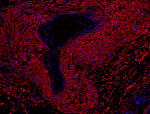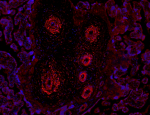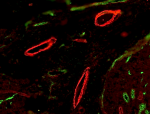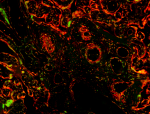- Clone
- A16085I (See other available formats)
- Regulatory Status
- RUO
- Other Names
- VEGFR2, KDR
- Isotype
- Mouse IgG2b, κ
- Ave. Rating
- Submit a Review
- Product Citations
- publications

-

Human paraffin-embedded placenta tissue slices were prepared with a standard protocol of deparaffinization and rehydration. Antigen retrieval was done with Tris-Buffered Saline 1X (1.0M, pH 7.4) at 95°C for 40 minutes. Tissue was washed with PBS/0.05% Tween 20 twice for five minutes and blocked with 5% FBS and 0.2% gelatin for 30 minutes. Then, the tissue was stained with 10 µg/mL of anti-human CD309/VEGFR2 (clone A16085I) Alexa Fluor® 594 (red) at 4°C overnight. Nuclei were counterstained with DRAQ5™ (blue). The image was captured with a 10X objective.
| Cat # | Size | Price | Quantity Check Availability | Save | ||
|---|---|---|---|---|---|---|
| 374003 | 25 µg | $159 | ||||
CD309, also known as VEGF-R2, KDR, and Flk-1 (mouse), is a type I transmembrane glycoprotein. It is a member of the CSF-1/PDGF receptor family of type III tyrosine kinase receptors. Human VEGF-R2 is mainly expressed by endothelial cells, embryonic tissues, and megakaryocytes. It plays an important role in the regulation of angiogenesis, vasculogenesis, and vascular permeability. The ligands of VEGF-R2 include VEGF-A, VEGF-C, and VEGF-D splice isoforms. Activation of VEGF-R2 with its ligands results in the receptor dimerization and autophosphorylation, stimulating endothelial cell proliferation and migration.
Product DetailsProduct Details
- Verified Reactivity
- Human
- Antibody Type
- Monoclonal
- Host Species
- Mouse
- Immunogen
- Recombinant Human VEGFR2-Fc Chimera
- Formulation
- Phosphate-buffered solution, pH 7.2, containing 0.09% sodium azide.
- Preparation
- The antibody was purified by affinity chromatography and conjugated with Alexa Fluor® 594 under optimal conditions.
- Concentration
- 0.5 mg/ml
- Storage & Handling
- The antibody solution should be stored undiluted between 2°C and 8°C, and protected from prolonged exposure to light. Do not freeze.
- Application
-
IHC-P - Quality tested
- Recommended Usage
-
Each lot of this antibody is quality control tested by immunohistochemistry. For immunohistochemistry, a concentration range of 5-10 μg/ml is suggested. It is recommended that the reagent be titrated for optimal performance for each application.
* Alexa Fluor® 594 has an excitation maximum of 590 nm, and a maximum emission of 617 nm.
Alexa Fluor® and Pacific Blue™ are trademarks of Life Technologies Corporation.
View full statement regarding label licenses - RRID
-
AB_2716157 (BioLegend Cat. No. 374003)
Antigen Details
- Structure
- Type I transmembrane glycoprotein, type III tyrosine kinase receptor, CSF-1/PDGF receptor family
- Distribution
-
Endothelial cells, embryonic tissues
- Function
- VEGFR2 regulates angiogenesis as well as vascular development and permeability
- Interaction
- VEGF-A, SHC2, NPR1, NCK1
- Ligand/Receptor
- VEGF-A, VEGF-C, and VEGF-D splice isoforms
- Cell Type
- Endothelial cells
- Biology Area
- Angiogenesis, Cell Biology, Immunology
- Molecular Family
- CD Molecules, Cytokine/Chemokine Receptors
- Antigen References
-
1. DiSalvo J, et al. 1995. J. Biol. Chem. 270:7717.
2. McColl BK, et al. 2003. J. Exp. Med. 198:863.
3. Albuquerque RJ, et al. 2009. Nat. Med. 15:1023.
4. Guangqi E, et al. 2012. J. Biol. Chem. 287:3029.
5. Koch S, and Claesson-Welsh 2012. Cold Spring Harb Perspect Med 2:a006502.
6. Munaut C, et al. 2012. Plos One 7:e33475.
7. Wehland M, et al. 2013. Int. J. Mol. Sci. 14:9338. - Gene ID
- 3791 View all products for this Gene ID
- UniProt
- View information about CD309 on UniProt.org
Related FAQs
Other Formats
View All CD309 Reagents Request Custom Conjugation| Description | Clone | Applications |
|---|---|---|
| Purified anti-human CD309 (VEGFR2) | A16085I | IHC-P |
| Alexa Fluor® 594 anti-human CD309 (VEGFR2) | A16085I | IHC-P |
| Spark YG™ 570 anti-human CD309 (VEGFR2) | A16085I | IHC-P |
Compare Data Across All Formats
This data display is provided for general comparisons between formats.
Your actual data may vary due to variations in samples, target cells, instruments and their settings, staining conditions, and other factors.
If you need assistance with selecting the best format contact our expert technical support team.
-
Purified anti-human CD309 (VEGFR2)

Human paraffin-embedded placenta tissue slices were prepared... 
Human paraffin-embedded breast cancer section slices were pr... 
Human paraffin-embedded placenta tissue slices were prepared... 
Human paraffin-embedded tonsil tissue slices were prepared w... -
Alexa Fluor® 594 anti-human CD309 (VEGFR2)

Human paraffin-embedded placenta tissue slices were prepared... -
Spark YG™ 570 anti-human CD309 (VEGFR2)

Human paraffin-embedded placenta tissue slices were prepared...
 Login/Register
Login/Register 














Follow Us